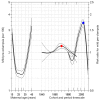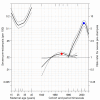Pre-eclampsia rates in the United States, 1980-2010: age-period-cohort analysis
- PMID: 24201165
- PMCID: PMC3898425
- DOI: 10.1136/bmj.f6564
Pre-eclampsia rates in the United States, 1980-2010: age-period-cohort analysis
Abstract
Objective: To estimate the contributions of biological aging, historical trends, and birth cohort effects on trends in pre-eclampsia in the United States.
Design: Population based retrospective study.
Setting: National hospital discharge survey datasets, 1980-2010, United States.
Participants: 120 million women admitted to hospital for delivery.
Main outcome measures: Temporal changes in rates of mild and severe pre-eclampsia in relation to maternal age, year of delivery, and birth cohorts. Poisson regression as well as multilevel age-period-cohort models with adjustment for obesity and smoking were incorporated.
Results: The rate of pre-eclampsia was 3.4%. The age-period-cohort analysis showed a strong age effect, with women at the extremes of maternal age having the greatest risk of pre-eclampsia. In comparison with women delivering in 1980, those delivering in 2003 were at 6.7-fold (95% confidence interval 5.6-fold to 8.0-fold) increased risk of severe pre-eclampsia. Period effects declined after 2003. Trends for severe pre-eclampsia also showed a modest birth cohort effect, with women born in the 1970s at increased risk. Compared with women born in 1955, the risk ratio for women born in 1970 was 1.2 (95% confidence interval 1.1 to 1.3). Similar patterns were also evident for mild pre-eclampsia, although attenuated. Changes in the population prevalence of obesity and smoking were associated with period and cohort trends in pre-eclampsia but did not explain the trends.
Conclusions: Rates of severe pre-eclampsia have been increasing in the United States and age-period-cohort effects all contribute to these trends. Although smoking and obesity have driven these trends, changes in the diagnostic criteria may have also contributed to the age-period-cohort effects. Health consequences of rising obesity rates in the United States underscore that efforts to reduce obesity may be beneficial to maternal and perinatal health.
Conflict of interest statement
Competing interests: None of the authors report any potential conflict of interest.
Competing interests: All authors have completed the ICMJE uniform disclosure form at
Figures



References
-
- Campbell DM, MacGillivray I, Carr-Hill R. Pre-eclampsia in second pregnancy. Br J Obstet Gynaecol 1985;92:131-40. - PubMed
-
- Basso O, Christensen K, Olsen J. Higher risk of pre-eclampsia after change of partner. An effect of longer interpregnancy intervals? Epidemiology 2001;12:624-9. - PubMed
-
- Skjaerven R, Wilcox AJ, Lie RT. The interval between pregnancies and the risk of preeclampsia. N Engl J Med 2002;346:33-8. - PubMed
-
- Conde-Agudelo A, Belizan JM, Diaz-Rossello JL. Epidemiology of fetal death in Latin America. Acta Obstet Gynecol Scand 2000;79:371-8. - PubMed
MeSH terms
LinkOut - more resources
Full Text Sources
Other Literature Sources
Medical
